
The Xiaomi Mi 11 Ultra and the Oppo Find X3 Pro both belong to the top 1% of the smartphone elite. With their premium materials and their bulging camera modules, these devices stand imperiously above all those regular flagships selling for less than $1,000 / £1,000.
But which is the better ultra-premium handset of the two? Which phone best combines luxury with day-to-day usability?
No bets are going to be hedged in this titanic face-off, we assure you. Come the final reckoning, we’re going to be presenting you with a clear winner.
Xiaomi Mi 11 Ultra vs Oppo Find X3 Pro price and availability
The Xiaomi Mi 11 Ultra landed on April 2, 2021. It costs £1,199 / AU$1,799 (around $1,600) for 256GB of storage.

Oppo got its plush swimming towel down a tad earlier on March 19, just over a week after its unveiling. The solitary model with 12GB of RAM and 256GB of storage costs a chunky £1,099 / AU$1,699 (which converts to roughly $1,500).
As you may have guessed from those dollar estimations, neither phone is available to buy in the US, which is disappointing. Still, there are always options to import, if you’re really keen.
Design
Our reviewer wasn’t massively taken by the Oppo Find X3 Pro’s svelte design. It certainly isn’t as in-your-face gorgeous as the Oppo Find X2 Pro with its vegan leather and ceramic finishes.
Get daily insight, inspiration and deals in your inbox
Get the hottest deals available in your inbox plus news, reviews, opinion, analysis and more from the TechRadar team.
However, compared to the Xiaomi Mi 11 Ultra (which, ironically, does come with a ceramic finish), it’s a veritable supermodel.
At 163.6 x 74 x 8.3mm, the Oppo phone would appear to be almost identically proportioned to the 164.3 x 74.6 x 8.4mm Xiaomi. But that thickness tells only half the story. It doesn’t so much as hint at the whopping great camera module that takes up almost the entire top-third of the Xiaomi Mi 11 Ultra’s shiny rear surface.
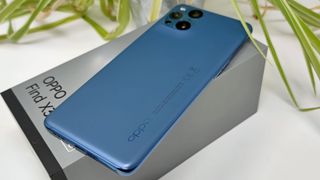
With this hefty ridge taken into account, you’re really looking at a thickness upwards of 10mm. And while the Oppo also has a protruding camera module, it’s that rarest of phones that makes a virtue of that bulge.
Oppo has crafted a beautiful sweep of glass to seamlessly encompass its lens array, meaning there’s nothing to snag on your pockets as you slip it in and out. It really is top craftsmanship, and it stands at the polar opposite to its crass rival.
This opposing approach manifests in another way. The Xiaomi Mi 11 Ultra weighs an alarming 234g, whereas the Oppo Find X3 Pro comes in at a way more manageable 193g. The difference in the hand, not to mention the pocket, is stark.
You might struggle to tell the two phones apart from the front, however. They’re both represented by handsome, curved stretches of glass, lightly framed by shiny metal rims that expand at the corners for reinforcement.
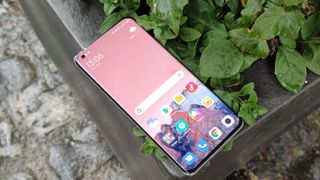
They’re equally water- and dust-resistant, too, with a shared IP68 rating. But make no mistake – the Oppo Find X3 Pro is the better-designed phone, and is much easier to live with day to day.
Display
There isn’t an awful lot to separate these two displays, which are among the very best you can get in mid-2021.
The Xiaomi Mi 11 Ultra sports a 6.81-inch AMOLED display with a 120Hz refresh rate and a 3200 x 1440 resolution, the latter two of which can be achieved simultaneously. The Oppo Find X3 Pro has a 6.7-inch AMOLED screen with a 120Hz refresh rate and a 3216 x 1440 resolution, which can also be active at the same time.
Besides the small disparity in size, the key difference here is peak brightness. While the Oppo can manage a very good 1,300nits, the Xiaomi can reach an eyeball-scorching 1,700nits in super-bright conditions.
That aside, these are two excellent screens in terms of sharpness, contrast and color accuracy. The Oppo punches up the colors a little more and seems warmer out of the box, but both displays are highly tweakable, so you can adjust the tone to suit. You won’t feel short-changed with either screen, even with those four-figure price tags.
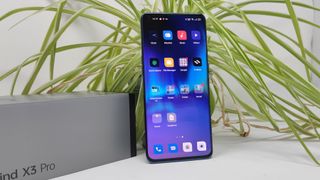
Both phones include optical in-display fingerprint sensors, but on this front we’d give the Oppo the edge. While the Xiaomi Mi 11 Ultra’s sensor didn’t always recognise our prints as reliably as we’d have liked, the Oppo Find X3 Pro typically proved snappy and reliable.
The Mi 11 Ultra has another display we should talk about. This tiny 1.1-inch screen sits on the back of the phone as part of its oversized camera module. It’s essentially the same display as you’ll find in the Xiaomi Mi Band 6 fitness tracker.
In practice, though, this secondary display is rather superfluous. When active it will display the time and battery level, although it doesn’t always seem to be there when you’d like it. It can also serve as a camera viewfinder for vastly improved selfies, but it’s too small to help you do anything more than approximate framing. It also serves as a music app control shortcut, but we found it to be prone to accidental touches.
Cameras
As always with these super-flagship phones, there’s some considerable flexing in the camera department. Both Xiaomi and Oppo make boastful claims about their respective photographic skills.
Thankfully, both phones acquit themselves very well indeed, although they have differing approaches and strengths. In a nutshell: the Xiaomi is all about an abnormally huge main sensor and stand-out zoom capabilities, while the Oppo is all about a supremely balanced offering that includes a stand-out ultra-wide.

Both phones lead with a 50-megapixel main sensor, but the Xiaomi’s is considerably larger at 1/1.56in. Not that the Oppo’s 1/1.12in sensor is small or under-equipped, you understand. It’s the Mi 11 Ultra that’s the outlier here, with a sensor that’s almost as big as that of a top-end point-and-shoot camera such as the Sony RX100.
Sure enough, the Xiaomi takes fantastically bright and bold shots that pretty much hoover in light, with nicely natural-looking depth effects and bags of detail. Exposure is on point, too.
We can’t really fault the shots taken with the Oppo, either. These too appear bold, colorful, and are bursting with detail. Digital Overlap HDR (DOL-HDR) technology works to reduce ghosting in HDR shots by shooting long and short exposures in super-quick succession.
What’s truly impressive, though, is the fact that the very same Sony IMX766 image sensor used in the main camera can also be found in the ultra-wide. There’s a rare uniformity to shots taken across both cameras as a result, alongside a distinct lack of the usual distortion.
Switch back to the Xiaomi, and while it too sports a 48-megapixel ultra-wide, we found it to produce shots with noticeable distortion at the edges.
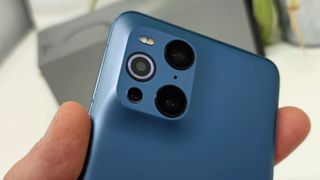
The Xiaomi Mi 11 Ultra hits back with an impressive 48-megapixel periscope lens, which produces impressively detailed 5x shots. Xiaomi’s claims that you can get usable 120x hybrid zoom shots are rather fanciful, but 10x is certainly feasible. The Oppo Find X3 Pro only has a 13-megapixel 2x telephoto sensor to rely on, so anything above 3x looks a little anaemic.
The Oppo Find X3 Pro adds a fourth sensor in the shape of a 3-megapixel Microlens camera. It can capture 60x extreme closeups if you’re really patient with it, which can look quite cool. But it’s still a bit of a gimmick, if we’re being honest.
When it comes to front-facing cameras, the Xiaomi has a 20-megapixel unit versus the Oppo’s 32-megapixel equivalent. Both are fine at what they do, although of course the Xiaomi offers the possibility of using the main camera for superior selfies thanks to that secondary display.
On the video front, the Xiaomi Mi 11 Ultra can capture 8K at 24fps or 4K up to 60fps. The Oppo Find X3 Pro, on the other hand, can only manage the latter. Of course, the practicality of 8K video is rather questionable – but, in general, both phones take great videos.
Specs and performance
Both the Xiaomi Mi 11 Ultra and the Oppo Find X3 Pro pack Qualcomm’s Snapdragon 888. It shouldn’t surprise you, then, to learn that performance is very much within the same postal code – especially when you consider that both feature 12GB of RAM.
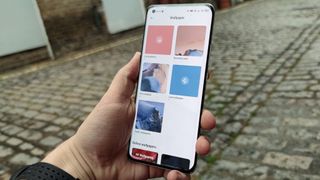
Not surprisingly, when we run these two phones through the usual benchmark tests, they’re closely matched. In Geekbench 5’s CPU-focused test, both score around 3,300 for multi-core.
In 3DMark’s GPU-focused Wild Life Extreme test, meanwhile, they each score around the 1,500 mark. Needless to say, we’re talking distinctly high-end stats in both cases.
That’s borne out in day-to-day use, where both phones are a delight to use. You’re getting a true 120Hz experience in both cases, with stutter-free scrolling through home screens, menus and apps.
There is one difference at play here, and while it relates to display technology, it has more of a bearing on gaming performance. While the Oppo Find X3 Pro’s display sports a more than respectable touch sampling rate of 240Hz, the Xiaomi Mi 11 Ultra doubles up with an incredible 480Hz. This means that it reads your touch inputs twice as fast, which should be of great interest to competitive gamers.
Both phones offer 256GB of internal storage as standard, which should be ample for most people. It will have to be, in fact, because neither phone has a microSD slot.

How do you like your Android 11? If you answered “bright and highly customisable”, then either phone is going to be a good bet. Xiaomi’s MIUI is the slightly busier of the two, with some annoying bloatware and one or two bugs.
Oppo’s ColorOS feels slightly more restrained to our eyes, with clean icon design, a configurable always-on display, and generally fewer snags. In truth, neither is our favorite Android skin, but the Oppo Find X3 Pro causes the least friction of the two.
Battery life
One of the reasons the Xiaomi Mi 11 Ultra is so much bulkier than the Oppo Find X3 Pro is its larger battery – we’re talking 5,000mAh for the Xiaomi and 4,500mAh for the Oppo. Curiously, though, that doesn’t really translate to a stamina advantage for the larger phone.
We found that the Oppo Find X3 Pro would last through a day of light to medium use. Only with a heavier load, such as when playing lots of games or recording lots of video, would we find that it didn’t last through a full 12-hour day shift.
With the Xiaomi Mi 11 Ultra, on the other hand, we often found ourselves finishing up a day of light to moderate use with just 10 to 20% of a charge left in the tank. A heavier load would see the phone completely drained before bed time.

What can be blamed for this? We’re not 100% sure; but we did observe that the Xiaomi Mi 11 Ultra ran rather hot under heavy load. Perhaps the Oppo has a better cooling system or superior software optimisation.
Remember, too, that the Xiaomi has a larger, brighter and more touch-responsive display, which would place further strain on that battery. Whatever the case, it isn’t a night and day difference. Neither of these phones is a stamina champ, and in both cases a combination of 120Hz and 5G connectivity is going to bring that battery percentage down sharpish.
Thankfully, both phones recharge extremely quickly. The Xiaomi Mi 11 Ultra comes with a 67W wired charger, while the Oppo Find X3 Pro offers a similarly speedy 65W equivalent. Both can take you from 0–100% in around half an hour, which is amazing.
Xiaomi also offers support for 67W wireless charging, which is a win over the Oppo’s (still fast) 30W.
Takeaway
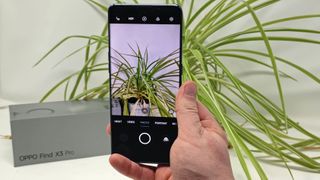
Which £1100/$1500 flagship smartphone should you buy? It’s a nice decision to have to make, if that’s your position, and in many ways everyone’s a winner. These are two powerful phones filled with cutting-edge components.
We’d give the Oppo Find X3 Pro the clear edge, however – and it largely comes down to design. Its slender, flowing chassis proves to be both more tasteful and more practical on a day-to-day basis. The Xiaomi Mi 11 Ultra simply feels like it’s trying a little too hard, with a ridiculously large camera module hosting a superfluous secondary display.
We wouldn’t say that Xiaomi’s pronounced camera is any better overall, either. It wins on zoom, and its huge main sensor captures stunningly bright and detailed shots. However, the Oppo wins for consistency, with a brilliantly balanced and distortion-free ultra-wide that works in tandem with a similarly accomplished main sensor.
Between these two highly desirable phones, the Oppo Find X3 Pro simply has fewer rough edges. And rough edges count for a lot when you’re spending this much money.
